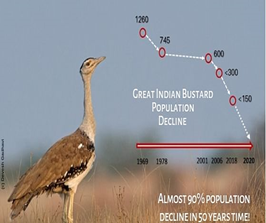

Context
The Supreme Court sought the government's response about evolving a 'Project Great Indian Bustard' conservation programme to bring attention to the peril faced by the Species.
Background:
|
It is the State bird of Rajasthan and has its habitat mostly confined to the region of Rajasthan, and Gujarat. |
- The Great Indian Bustard (GIB) is considered India’s most critically endangered bird and is protected under the Wildlife Protection Act.
- Its population of about 150in Rajasthan accounts for 95% of its total world population.
- The captive breeding of GIBswas taken up in the Desert National Park through a project executed by the Dehradun-based Wildlife Institute of India in 2019.
About
The Great Indian Bustard (GIBs):
- The Great Indian Bustard (Ardeotis nigriceps), is a bustard native to the Indian subcontinent. Bustards are large terrestrial birdsfound in dry grasslands and steppe regions.
- It is also known as the Indian Bustard; it is among the heaviest flying birds in existence.
- It is the State bird of Rajasthanand is considered India’s most critically endangered bird.
- It is considered the flagship grassland species, representing the health of the grassland ecology.
- The GIB is now found in a small number only in western Rajasthan, while Gujarat claims to have a few females left in its Banni Grassland Reserve.
- Population:As per the last count of the GIB in 2018, there were around 127 birds in the Desert National Park or the DNP in Rajasthan.

|
Protection Status:
|
Reasons behind the declining population of GIBs:
- As Rajasthan shares the international borderwith Pakistan’s Sindh and Punjab provinces, it is suspected that the GIBs might have flown across to the neighbouring country’s desert.
- The GIBs in the Thar Deserthas been facing threat to their survival because of intensive agricultural practices, lying of power lines, and industrialization.
- Experts have observed that the endangered birds have raised their families within the Desert National Park and outside in the rural pockets, where feed and grassland habitat is available.
- They also move in the crop fields to pick up insects and lizards and like to hide there.
|
The GIB- Breeding Project: The WII's team has been working on ex-situ breeding of GIB for the last three years. They are aiming at preserving the GIBs. |


